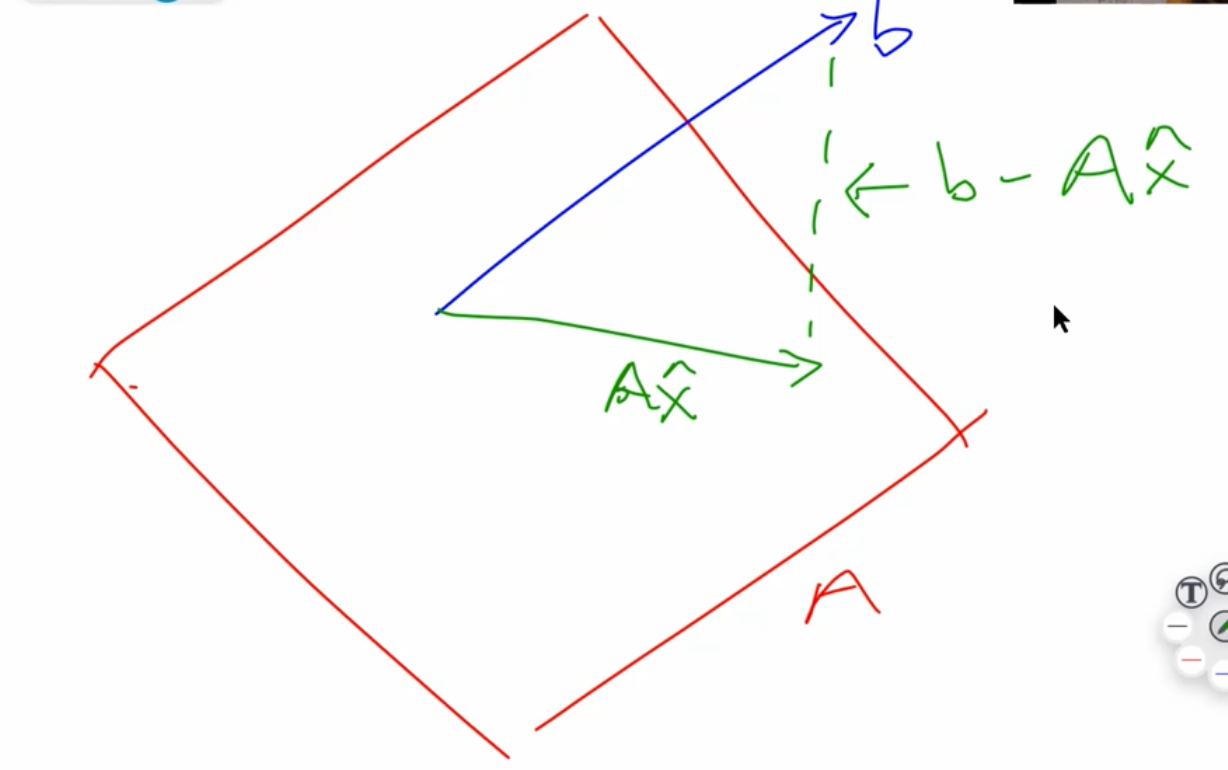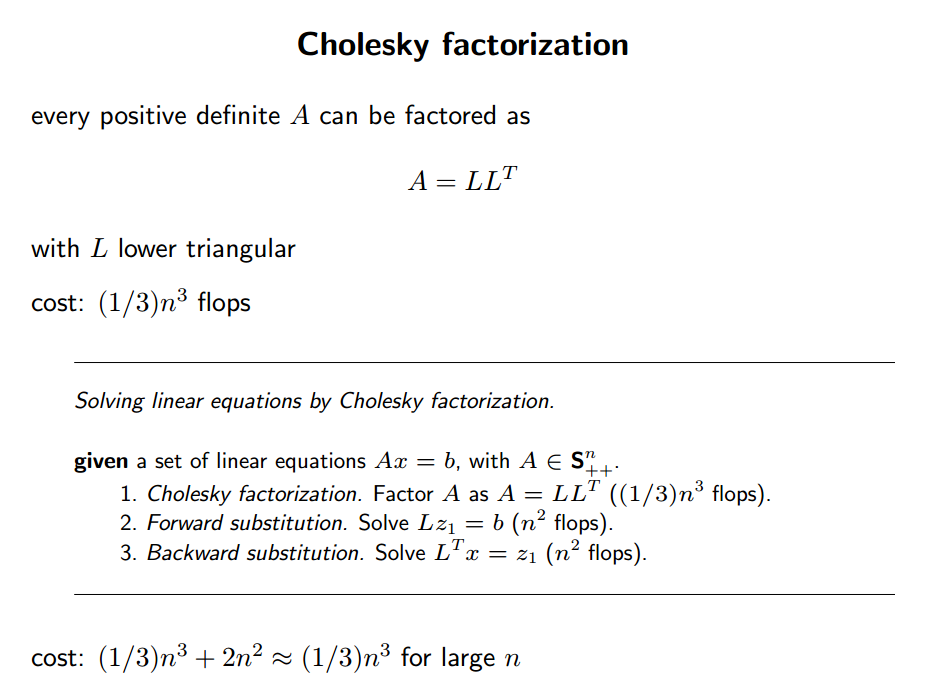线性回归的N种姿势
2018-03-01 18:57
323 查看
1. Naive Solution
We want to find x̂ x^ that minimizes:∣∣∣∣Ax̂ −b∣∣∣∣2||Ax^−b||2
Another way to think about this is that we are interested in where vector bb is closest to the subspace spanned by AA (called the range of AA). Ax̂ Ax^ is the projection of bb onto AA. Since b−Ax̂ b−Ax^ must be perpendicular to the subspace spanned by AA, we see that
AT(b−Ax̂ )=0AT(b−Ax^)=0

(we are using ATAT because we want to multiply each column of AA by b−Ax̂ b−Ax^
This leads us to the normal equations:
x=(ATA)−1ATbx=(ATA)−1ATb
但是这种方法不是很practical,因为要求矩阵的逆,比较麻烦。
def ls_naive(A, b): # not practical,因为直接求了矩阵的逆,很麻烦 return np.linalg.inv(A.T @ A) @ A.T @ b coeffs_naive = ls_naive(trn_int, y_trn) regr_metrics(y_test, test_int @ coeffs_naive)
2. Cholesky Factorization
Normal equations:ATAx=ATbATAx=ATb
If AA has full rank, the pseudo-inverse (ATA)−1AT(ATA)−1AT is a square, hermitian positive definite matrix.
【注意】Cholesky一定要是正定矩阵!虽然这个操作又快又好,但是使用场景有限!
The standard way of solving such a system is Cholesky Factorization, which finds upper-triangular R such that ATA=RTRATA=RTR. ( RTRT is lower-triangular )
AtA = A.T @ A Atb = A.T @ b R = scipy.linalg.cholesky(AtA) # check our factorization np.linalg.norm(AtA - R.T @ R)
Q:为啥变成 RTRx=ATbRTRx=ATb 会变简单?
之前提过,上三角矩阵解线性方程组时会简单许多(最后一行只有一个未知数)。
所以先求 RTw=ATbRTw=ATb 再求 Rx=wRx=w 会easier。
ATAx=ATbRTRx=ATbRTw=ATbRx=wATAx=ATbRTRx=ATbRTw=ATbRx=w
def ls_chol(A, b): R = scipy.linalg.cholesky(A.T @ A) w = scipy.linalg.solve_triangular(R, A.T @ b, trans='T') return scipy.linalg.solve_triangular(R, w) %timeit coeffs_chol = ls_chol(trn_int, y_trn)
3. QR Factorization
QQ is orthonormal, RR is upper-triangular.Ax=bA=QRQRx=bQ−1=QTQTQRx=QTbRx=QTbAx=bA=QRQRx=bQ−1=QTQTQRx=QTbRx=QTb
Then once again, RxRx is easier to solve than AxAx.
def ls_qr(A,b): Q, R = scipy.linalg.qr(A, mode='economic') return scipy.linalg.solve_triangular(R, Q.T @ b) coeffs_qr = ls_qr(trn_int, y_trn) regr_metrics(y_test, test_int @ coeffs_qr)
4. SVD
都是同样的问题,要求 xx。 UU 的column orthonormal,∑∑ 是对角阵,VV 是row orthonormal.Ax=bA=UΣVΣVx=UTbΣw=UTbx=VTwAx=bA=UΣVΣVx=UTbΣw=UTbx=VTw
解 Σw=UTbΣw=UTb 甚至比上三角矩阵 RR 更简单(每行只有一个未知量)。然后 Vx=wVx=w 又可以直接用orthonormal的性质,直接等于 VTwVTw。
SVD gives the pseudo-inverse.
def ls_svd(A,b): m, n = A.shape U, sigma, Vh = scipy.linalg.svd(A, full_matrices=False, lapack_driver='gesdd') w = (U.T @ b)/ sigma return Vh.T @ w coeffs_svd = ls_svd(trn_int, y_trn) regr_metrics(y_test, test_int @ coeffs_svd)
5. Timing Comparison
Matrix Inversion: 2n32n3Matrix Multiplication: n3n3
Cholesky: 13n313n3
QR, Gram Schmidt: 2mn22mn2, m≥nm≥n (chapter 8 of Trefethen)
QR, Householder: 2mn2−23n32mn2−23n3 (chapter 10 of Trefethen)
Solving a triangular system: n2n2

Why Cholesky Factorization is Fast:

(source: Stanford Convex Optimization: Numerical Linear Algebra Background Slides)
相关文章推荐
- 线性回归2(局部加权回归)
- 机器学习(三):局部加权线性回归算法、Logistic回归算法
- 线性回归程序1
- Java集成Weka做线性回归的例子
- 线性回归及梯度下降-机器学习1
- python 线性回归示例
- 线性回归的补充与变量归一化
- 多元线性回归multivariable linear regression
- 线性回归-4-欠拟合、过拟合与局部加权线性回归
- 线性回归Linear Regression
- 机器学习入门:线性回归及梯度下降
- 用Python实现机器学习算法:线性回归
- 多元线性回归
- 从最大似然再看线性回归
- SPSS统计分析过程包括描述性统计、均值比较、一般线性模型、相关分析、回归分析、对数线性模型、聚类分析、数据简化、生存分析、时间序列分析、多重响应等几大类
- 线性回归、梯度下降(Linear Regression、Gradient Descent)
- 【自然语言处理入门】03:利用线性回归对数据集进行分析预测(下)
- 线性回归 Linear Regression
- sklearn系列之----线性回归
- 十大统计技术,包括线性回归、分类、重采样、降维、无监督学习等。
